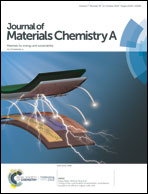An “electronegative” bifunctional coating layer: simultaneous regulation of polysulfide and Li-ion adsorption sites for long-cycling and “dendrite-free” Li–S batteries†
Abstract
Lithium–sulfur (Li–S) batteries are of great interest due to their high theoretical energy density and potentially low cost. However, two of the key issues hindering their commercialization are the polysulfide shuttling and Li-dendrite growth, which result in severe capacity decay and serious safety hazards. Herein, liquid-phase delaminated birnessite (HxMnO2+x) nanosheets along with graphene and carbon nanotubes are utilized for the first time to create an “electronegative” coating layer for Li–S batteries to suppress the polysulfide shuttling and Li-dendrite growth. The as-prepared coating layer enables stable cycling of the Li–S battery with a low capacity decay rate of 0.04% per cycle over 1000 cycles at 1C. In addition, a Li-symmetrical cell with the coating layer shows suppressed dendrite growth even after being cycled over 1000 hours at 1 mA cm−2. This excellent performance is ascribed, in part, to the synergistic effect of the chemical and electrostatic interactions among polysulfides, Li ions, and [MnO2+x]x− ions, resulting in a homogeneous Li-ion flux distribution and a mitigated polysulfide shuttling. The proposed concept of an “electronegative” bifunctional coating layer illustrates a simple and effective way to develop highly stable and safe Li–S batteries.



 Please wait while we load your content...
Please wait while we load your content...